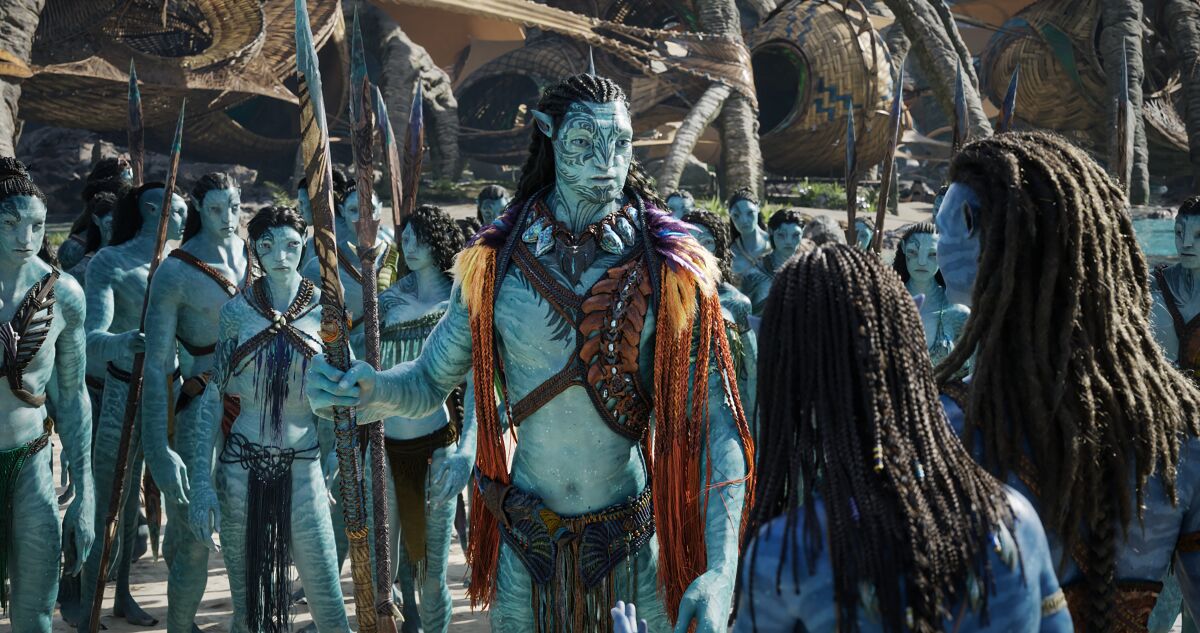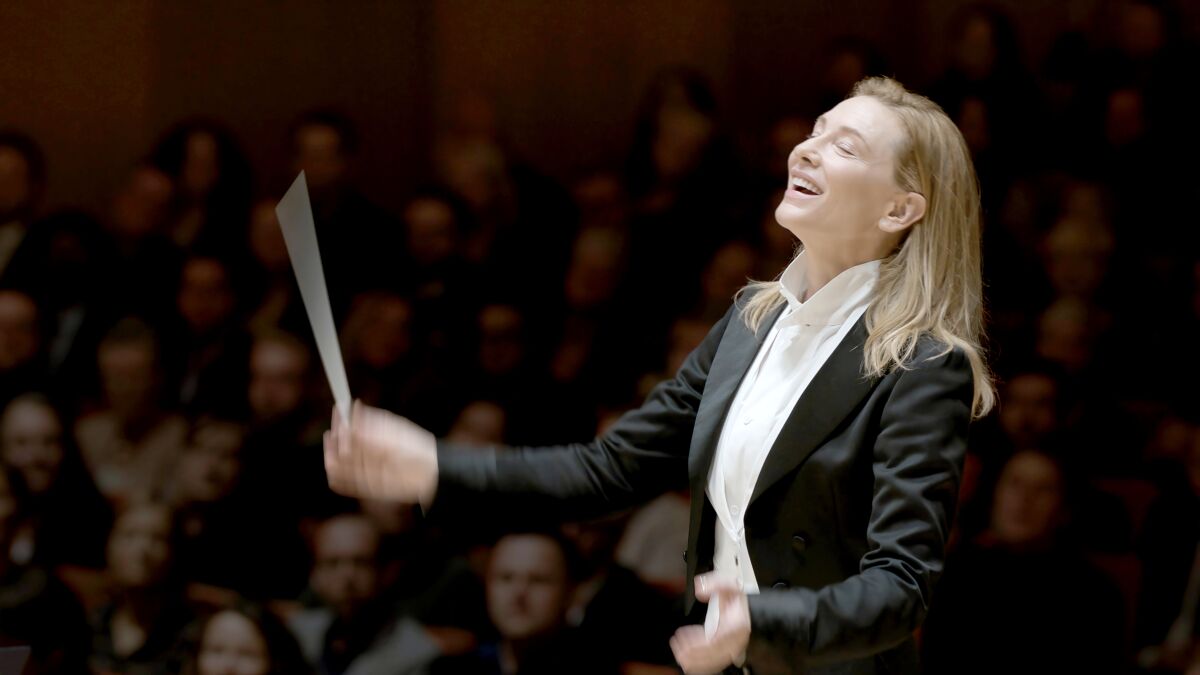If you were hoping to attract the largest possible viewership to the Academy Awards, it’s hard to think of many bigger names you could leverage than Tom Cruise, James Cameron and Elvis.
We’ll soon find out whether even that titanic trio can do the job.
The 10 best picture Oscar nominees unveiled by the motion picture academy early Tuesday morning span a wide range of styles and scales, from critical darlings that barely made a dent on the box office — like “Tár” and “All Quiet on the Western Front” — to bona fide blockbusters that drew huge audiences around the world, including “Top Gun: Maverick,” “Avatar: The Way of Water” and “Elvis.”
Frustrated by years of steadily declining ratings for the show long touted as Hollywood’s biggest night, academy leaders are hoping the inclusion of those box office hits will help goose interest in this year’s telecast, scheduled for March 12. Last year’s show drew an average of 15.4 million viewers, up 56% from the previous year but still the second-lowest viewership in Oscars history, and far below the more than 40 million who tuned in just nine years ago.
In a promising sign for the academy, this year marks the first time in Oscar history that more than one best picture contender has grossed more than $1 billion globally. The biggest hit of 2022, “Top Gun: Maverick” earned nearly $1.5 billion globally last summer, helping pull the film business out of its pandemic slump. Released in December, “Avatar: The Way of Water” has taken in nearly $2 billion around the world to date. (The last best picture nominee to cross the billion-dollar mark was 2019’s “Joker.”)
Two other best picture nominees this year, director Baz Luhrmann’s glitzy biopic “Elvis” and the gonzo sleeper sci-fi-action hit “Everything Everywhere All at Once,” have each taken in more than $100 million globally — a benchmark only one contender, “Dune,” surpassed among last year’s field and none managed to clear in 2021 at the height of the pandemic.

Stephanie Hsu, left, Michelle Yeoh and Ke Huy Quan in “Everything Everywhere All At Once.”
(A24)
Alongside these relative box office behemoths, a number of other contenders have struggled to reach a wide audience, as older moviegoers have remained slow to return to theaters.
The darkly comic frenemies story “The Banshees of Inisherin” has earned $27 million globally, while Steven Spielberg’s autobiographical “The Fabelmans” and the capitalist satire “Triangle of Sadness” each took in roughly $20 million around the world, with the remaining nominees lagging further behind.
Still, even without other potential high-earning contenders like “Black Panther: Wakanda Forever” and “RRR,” which both failed to make the cut, the cumulative gross of this year’s best picture field far exceeds any in recent years. Indeed, the $718-million domestic haul of “Top Gun: Maverick” alone nearly equals the worldwide grosses of the best picture nominees from the last two years put together.
In decades past, the tastes of audiences and Oscar voters tended to be in relatively close alignment, with hugely popular hits from “Gone With the Wind” and “The Sound of Music” to “The Godfather” and “Braveheart” earning the best picture prize. In 1997, the Oscars drew its biggest audience ever, with 55.3 million viewers tuning in to watch Cameron’s “Titanic” — then the biggest box office hit of all time — win 11 Academy Awards, including best picture.

A scene from James Cameron’s “Avatar: The Way of Water”
(20th Century Studios)
But over the years, the gulf between what the audience rewards at the box office and what Oscar voters reward with trophies has grown wider, creating an existential conundrum for the motion picture academy.
It’s been nearly 20 years since the biggest box office hit of the year was also crowned best picture. “The Lord of the Rings: The Return of the King” won the top prize at the 2004 Oscars, having brought in nearly $1.15 billion worldwide.
Faced with an ever more fragmented entertainment landscape, academy leaders have made various attempts to bring more broadly popular movies into the Oscar telecast, some more successful than others.
In 2009, following an outcry after the superhero smash “The Dark Knight” failed to land a best picture nomination, the academy expanded the best picture category to as many as 10 films in an effort to ensure more broadly appealing films would make the cut. Since then, only two comic-book movies have earned best picture nominations: “Black Panther” and “Joker.”
In 2018, with the best picture race still largely dominated by art-house fare, producer Bill Mechanic blasted the academy for its elitism in a blistering letter announcing his resignation from the organization’s board of governors. “Over the past decade we have nominated so many smaller independent films that the Oscars feel like they should be handed out in a tent,” he wrote. “Big is not inherently bad and small is not inherently good.”

Cate Blanchett portrays a fictional conductor, Lydia Tár, in director Todd Field’s “Tár.”
(Focus Features)
Later that year, the academy announced the creation of a new award to honor “outstanding achievement in popular film,” only to scrap the idea less than a month later amid criticism that it represented an ill-conceived act of pandering.
Last year, in another gambit aimed at luring casual movie fans, the telecast introduced the Oscars’ first-ever (and perhaps last-ever) fan-favorite award, voted on via Twitter. The subject of widespread derision in the run-up to the show, the top vote getter in the end was Netflix’s critically derided zombie heist film “Army of the Dead,” which was boosted to victory by director Zack Snyder’s rabid army of online devotees.
It remains to be seen whether academy voters will reward one of this year’s blockbusters with its top prize or whether the group will favor an arty David over a more populist Goliath.
One need only look to Cameron’s own Oscars history for a note of caution.
The last time Cameron was in the best picture race was in 2010, when the first “Avatar” earned nine Oscar nominations on its way to becoming the highest-grossing film of all time.
The ultimate winner that year? Kathryn Bigelow’s gritty Iraq war drama “The Hurt Locker,” which earned $17 million domestically, the lowest haul at the time for any best picture winner in modern history.
For all the latest Entertainment News Click Here
For the latest news and updates, follow us on Google News.
